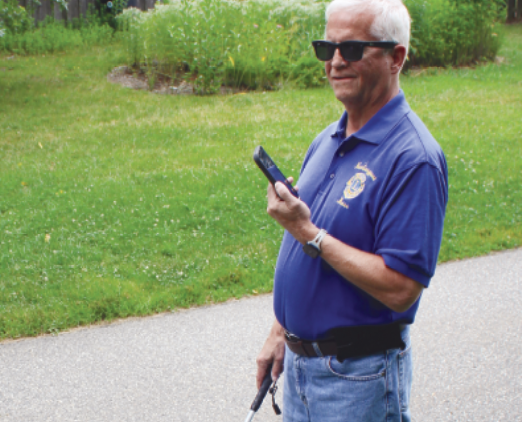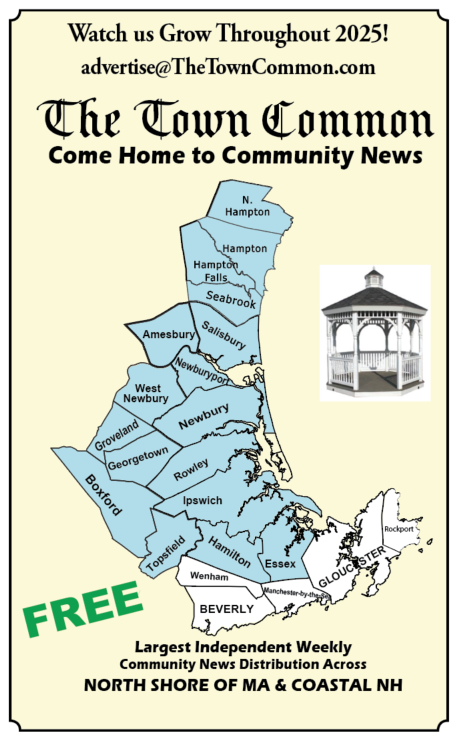NEWBURYPORT – The beloved Clipper City Rail Trail with its interesting sculptures and interpretative signage is easy to navigate — if you can see.
Now thanks to new technology being installed by the Newburyport Lions Club, even walkers with low vision will soon be able to feel safe using the trail.
And that is only the beginning of the potential of this technology that is likely to attract widespread attention for Newburyport and the Clipper City Rail Trail.
It is an idea spawned by the Newburyport Lions Club president Barbara Round, who is sighted, and spearheaded by Steve Baran, who has been blind from birth. The 30-member Lions Club, whose mission is to aid the blind, spent $22,000 buying 17 beacons from an Israeli company, RightHear, that, once installed fully, will play a message at each location along the trail on a free cell phone app.
The messages being developed now are largely directional, a first for most rail trails to be inclusive of low-vision users. But it may prove to be just as valuable as an electronic concierge or tour guide for visitors and newcomers to Newburyport as well as solve the challenge of adding more directional signage.
For example, as trail users start north from the MBTA rail station, the message broadcast by a female voice to the app on the cell phone, says:
From the train station face forward straight ahead at 12 o’clock you cross Parker Street. When approaching the crosswalk there are detectable dome warning tiles with a flashing light to your left. Cross diagonal to 11 o’clock to continue on the trail. Once across, continue walking straight, the next beacon will be 528 feet or 230 steps with more directions.
The directional messages are helpful to those with low vision or, as one sighted walker said last week, it will be helpful for those who are directionally challenged. Rounds, who is a strong advocate for inclusivity, said, “If you join the rail trail at Low Street, how do you know which way is the waterfront?”
The beacon also gives different messages that describe the trail’s features that would be what a sighted person would see. The message says: There is a bench about 50 feet after entering the rail trail. After the bench is a garden with a pathway There are sculptures along the trail. The first sculpture, “Sparrows” by Dale Rogers (2011), shows two birds gliding side by side in vertically tilted posture.
Next, the message continues, is The Alchemical Garden and a Little Free Library. Then there is Clyde already waiting for you. “Clyde” is a horse sculpture by James Burnes (2009) made of corten weathering steel and black locust wood.
Geordie Vining, the city’s senior planner, who spearheaded the development of the rail trail, wrote, “We have worked from the beginning to make the Rail Trail universally accessible. In practice, that has primarily meant meeting the ADA (Americans with Disabilities Act) and state Architectural Access Board’s requirements for a design that supports those with mobility impairments, as well as hearing, etc.
“Until now, for a number of reasons, we have not been able to do very much about supporting those with vision impairment.”
Vining added: “Installing the RightHear beacons on the Rail Trail is a really positive proposal and a really interesting use of technology to make the CCRT more accessible to everyone. I like how the system seems set up to provide real-time orientation information to users, as well as information about various landmarks and facilities as well as hazards. E.g., the interpretive signs; the sculptures, gardens, and murals; the benches, tunnels, bridges, intersections, stairs, side paths, etc.”
Approved by the city’s Parks Commission, the beacons will be operational by September, Baran said. The Lions Club, which will maintain the beacons, purchased them on a three-year-contract with RightHear.
The beacons, installed in clear boxes on the trail’s mile markers, deliver the messages in 34 languages. So, if the Greater Newburyport Chamber of Commerce hosts a Chinese delegation to see the new Market Landing Park, the delegation can walk the rail trail and learn about it in their native language.
Currently Barans and his team from RightHear are “getting the bugs out,” he said. They are testing the range of the messages broadcast on the cell phone as well as what the words say.
A major test comes on August 12, when Baran has invited the low vision group at the Newburyport Senior Center to walk the trail and hear the messages broadcast on their phone app.
The project was born out of Baran’s frustration with so-called Braille Trails, which use guidewires to help low-vision trail users. But the equipment is very expensive, frays and gets hot in the sunlight and benefitted a limited number of people, Round said.
Baran read in a newsletter that the Natural Bridge State Park in Virginia was experimenting with the RightHear beacons. He and his wife, Denise Dodge, drove to Virginia in an ice storm last winter to learn more about the beacons.
“This is just what I am looking for,” Baran said.
The RightHear beacons met all of Baran’s objectives for the trail project. He wanted it to be easy to use, allow low-vision persons to walk safely and independently, help the most number of people and by broadcasting from existing mile markets, the beacons are non-invasive.
They can also be educational, providing information to the trail users, who don’t run or bike too fast and don’t have their headsets turned up.
Next step for Round and Baran, install the RightHear beacons in downtown so everyone can learn about the history of Newburyport and know which way to go for shopping or dinner. ♦




